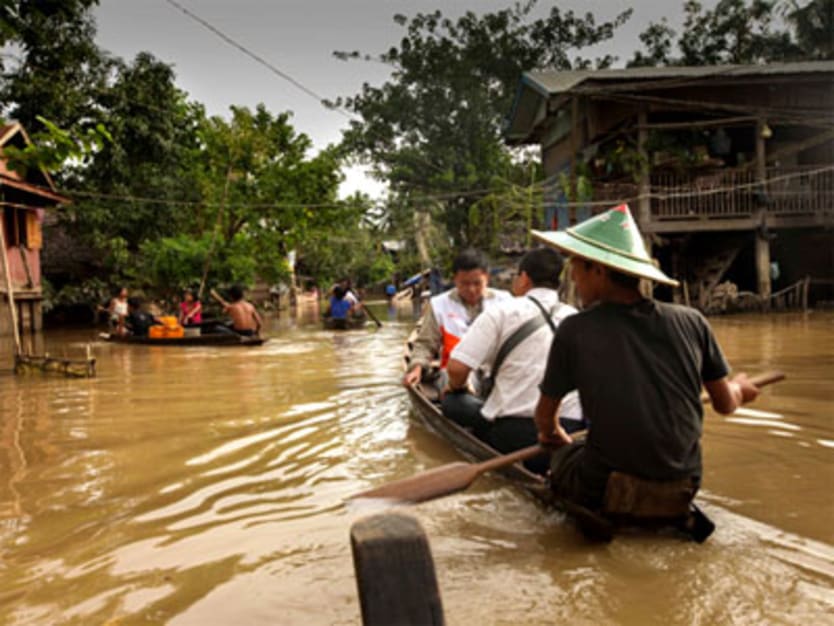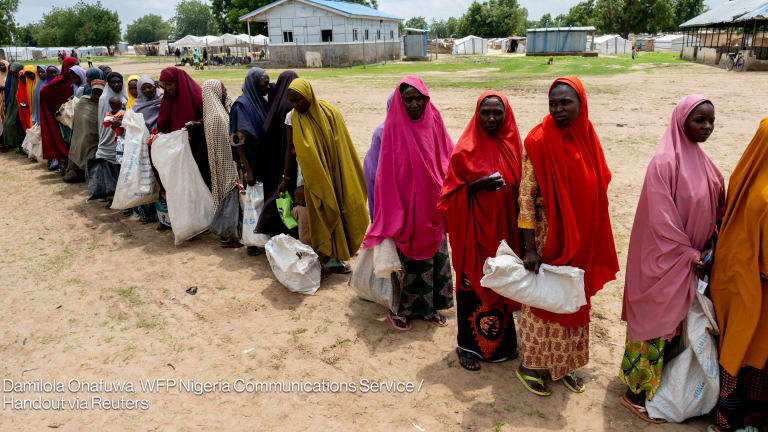
Seasonal floods recently displaced about 24,000 people in southeastern Myanmar, leaving the usual scenes of devastation in the submerged villages.
Little by little, the victims are starting to get back on their feet thanks to relief efforts by the government and NGOs. But at the same time, another picture of humanitarian response is emerging — a severe lack of coordination amid the outpour of foreign aid to Myanmar, Asia’s new “donor darling.”
Aid workers cannot easily access villages in conflict-ridden and far-flung areas without government approval, which hinders the deployment of resources, and the organisations that do manage to reach the communities are local NGOs unable to get funding from top donors and that remain dependent on foreign partners that are prevented from helping them out on the ground.
The government claims to be on top of the relief effort, but some organizations dispute official assessments, and while aid coordination has improved from the past — especially through the establishment of clusters — implementers consulted by Devex said the system is still “a work in progress” with much room for improvement.
Since Myanmar started opening up less than three years ago, foreign donors are lining up to finance all sorts of projects, open offices and establish multi-donor funds for the country, while multilateral banks have extended loans for ODA projects and private corporations are equally interested in investing in this former pariah state.
The money is indeed flowing, but maybe too fast for the government to cope.
MoU first
With lots of work to be done, respected NGOs, international consulting firms and all sorts of development actors are arriving in Myanmar and scouting local groups to partner with.
But aid agencies cannot just go into the country, put up bids, ask for funding and start work on the ground — they first need to negotiate a memorandum of understanding with the government.
MoUs spell what can and cannot be done in the country and are the government’s main strategy on aid coordination, although the process is plagued by red tape which most of the time ends up delaying aid delivery. For instance, some iNGOs working in the recent floods have yet to inform the government about their projects in some states like Kayin — the most affected region — because their MOUs do not cover them.
“The problem is that most of the agencies don’t have the permission to work in Kayin state,” noted Tauhid Ibne Farid, ActionAid’s program manager in Myanmar. “Without an MoU, you can’t work in many places and many organizations which have been trying [to work] over there [are still] waiting for their MoUs.”
And not only do aid partners have to get their MoUs before working on the ground, they also have to follow different rules and procedures set up by different ministries at the central government.
“Sometimes, it can be quite specific, like we would like you to work in this township. So if you want a broader coverage, you need to come back and discuss with the government,” said Plan International country director John McDonough. “Most NGOs wanting to work in different sectors will have [to secure] more than one MoU.”
Resources not spread out evenly
The bureaucratic process is constraining a constrained speedy response and unevenly spreading resources on the ground. Aid is crowding in to certain areas, while it remains scarce in other regions where it is equally or even more needed.
For instance, two organizations have disaster risk reduction projects in only three towns in Kayin, but in Rahkine state, 21 organizations have DRR programs (either completed or ongoing) in 19 towns, based on the a database compiled by the Myanmar Information Management Unit as of March 2013.
There are also sectors that get more projects than others.
Saetanar, a local NGO, completed its logistics project — the only one in this sector according to the database – last March. Most groups fund health or education projects, and five groups are pouring in funding for peace-building initiatives.
The system may have a bit more paperwork, but according to McDonough, it’s “workable” and at least now shorter and smoother than before. But until now, expats can hardly access most states affected by the recent flooding.
Shihab Uddin Ahamad, ActionAid’s country director in Myanmar, identified prolonged processes of travel authorization and limited or no access for foreign aid workers to certain areas as big barriers for effective coordination.
Aid partners thus have no alternative but to work through local NGOs before informing the government of their interest or while they are waiting for their MoUs.
“For us, the priority is to work with partners that are already present in the area. I think that’s the only way to go,” said Takeshi Komino, head of emergencies at Church World Service Asia-Pacific. “Of course, we’ll be informing the government about our plans but if we kind of limit to the MoU given to our team, then this would cause further delay.”
Distrust among NGOs?
The relationship between iNGOs and national NGOs, however, is not perfect, aid partners admit, as the influx of foreign aid has caused friction within the civil society sector in Myanmar.
“The criticism against iNGOs is that you know get chunks of the donors’ money that comes into the country,” explained Komino. “You’re using the local NGOs as contractors and not really giving the same respect to local partners. But if you take a look at it, it’s the local partners who are really implementing.”
A report by Myanmar-based group Local Resource Center in 2010 noted this common weakness among NGO partnerships: “Most local NGOs sense a lack of equal power in the partnership. This is partly due to a lack of iNGO experience and confidence, and a lack of attention by iNGOs in addressing the power differential.”
Though local NGOs receive grants or sub-grants from iNGOs and donors, they mostly get just “project-only support” and access to “core funding” remains elusive, thus “limiting local organizations to build organizational infrastructure, especially human resource capacity,” according to a 2012 follow-up report by LRC. That distrust reflects on the aid coordination mechanism in place, according to Komino: There are different clusters for iNGOs and lNGOs in the disaster risk reduction working group.
“We need to be careful in a way that the international ones don’t dominate the aid but have a proper exit strategy so that national ones after the current contract can do direct contracts with donor agencies,” he noted.
Some international organizations are conscious enough of the problem to set aside budget for local capacity building when they propose grants. ActionAid puts up a fellowship program aimed at training local young leaders, and Plan International has a full-time employee who looks after capacity building work.
Capacity building over big projects
At this point, some donors and aid agencies feel most local groups in Myanmar are not yet ready to handle big projects which demand high levels of compliance and capacity.
Aid partners say the situation on the ground is a classic case of demand outstripping supply — donors and iNGO partners cluster around or compete over the same local NGOs, according to reports by LRC.
A look at MIMU’s project database points to this observation: One local group, for instance, has partnerships with 15 iNGOs, U.N. agencies and local groups, and in most cases, local groups are connected with one or two foreign partners. But precisely big projects dominated the first wave of donor money thrown at the country after the generals embraced reform in late 2010.
“One of the key things that donors should do is [focus] more on building capacity rather than just implementing projects,” said McDonough. “But some donors prefer to see funds go to school building construction rather than capacity building.”
The U.S.-based think tank Brookings Institution shares this concern: “In the rush to get started and show quick results, donors inevitably design and begin implementing projects before their Myanmar counterparts are ready to participate meaningfully in this process.”
McDonough and other aid workers suggested that big projects should include capacity building work or donors should set aside more projects for local institution strengthening projects, and iNGOs should also establish programs aimed at helping their local counterparts.
‘Dual governance’
While iNGOs and local NGOs may have different objectives, they need to work hand in hand in reaching out to a host of people and groups – officially recognized by state or not — before implementing programs on the ground. Foreign aid partners in particular need to coordinate fully with the central and state governments.
“You may have state government not necessarily agreeing with central government on issues. Which is why if you’re an NGO, you need to go to both and try to do a little bit of your own coordination and get that going,” explained McDonough.
Decentralization appears to be a major sticky point — aid partners call for some responsibilities to be delegated to state governments to make sure coordination is fast and efficient, especially in humanitarian crises like the recent floods.
Conflict also adds another layer of complexity to working in Myanmar, where aid groups need permission from rebel groups to enter the territories the latter control.
“There’s some kind of dual management,” according to Farid. “Some communities believe in Karen National Union government and some believe in state-level government.”
The government is trying to address this and control the flow of aid through three different but linked coordination bodies, and donors set up a partnership group on aid effectiveness which meets regularly to avoid duplication of work. Both sides also came up early this year with an agreement that aims to foster dialogue among actors, align donor money with government plans and improve transparency.
But at the end of the day, aid partners say amid the influx of foreign aid money, Myanmar’s government is simply overstretched to meet the increasing demands of donors and other aid agencies, and is struggling to build its technical capacity in conducting rapid assessments in conflict areas.
“Over the couple of years, the government has done a lot,” said McDonough. “If you have a good coordination, the government needs ownership. They need process, institutions and planning. All of these need to be in place.”
Read more development aid news online, and subscribe to The Development Newswire to receive top international development headlines from the world’s leading donors, news sources and opinion leaders — emailed to you FREE every business day.








